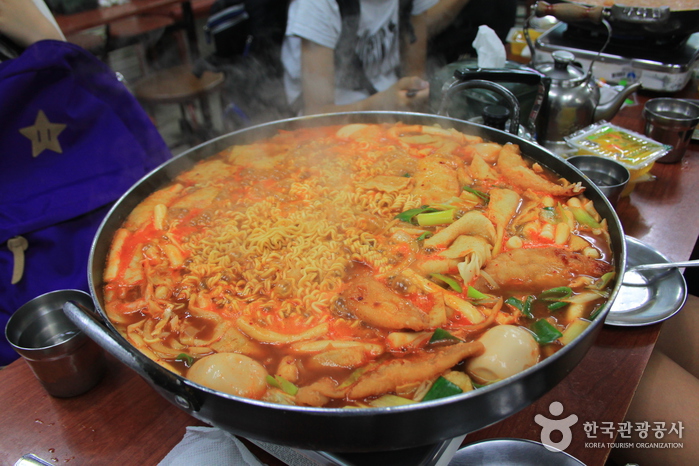When you go out in South Korea, you can see a lot of street food stands. Tteokbokki and Sundae are some of the most served snacks. Tteokbokki is made by boiling rice cakes, that have a cilindrical form, with rice cakes in a gochujang sauce. Tteokbokki dates back to the Joseon Dynasty. Back then it was a stir-fry made with rice cakes, mushrooms, meat, vegetables, and was seasoned with soy sauce. But, since after the Korean War soy sauce was hard to get, people made a new recipe. This new recipe consisted on seasoning the rice cakes with the spicy-sweet gochujang sauce (spicy fermented soya bean and red chilli sauce). You can taste a wide variety of tteokbokki in the Shindang-dong Tteokbokki town. The original restaurant of the gochujang tteokbokki is in this alley. But, on this restaurant they don´t serve it the same way street vendors do, they don´t serve it so hot and it is seasoned with gochujang ang jajang (black bean sauce). Many people say that this recipe was created by accident, when Mak Bo Rim (a street vendor) dropped the rice cakes in a bowl of chinese noodles with black bean sauce (jajangmyeon). Since they tasted good, she tried to do a recipe with this and sell them, and it was a total success.
Since in the 1970s food was more easy to get, people started adding boiled eggs, fish cakes, and glass noodles. In the 1980 many other tteokbokki restaurants started opening, each with a unique recipe. This was when the Shindang-dong tteokbokki town was formed. Since cooking tteokbokki is not an easy thing to do (it gets very messy) restaurants offer aprons. It is cooked on the table, many different ingridients are added, like onions, sauces, cabbage, eggs, mandu and different types of noodles. Many people even ask for more of these!
Tteokbokki has risen to fame, many new restaurants have been opened. Also, every october, there is a festibal of tteokbokki in Shindang-dong town where you can taste many different tteokbokki recipes, listen to music and see traditional dances. It´s a total parade! I would love to go, tteokbokki is a dish I´m looking forward to try when I go to Korea this summer.
Source:








